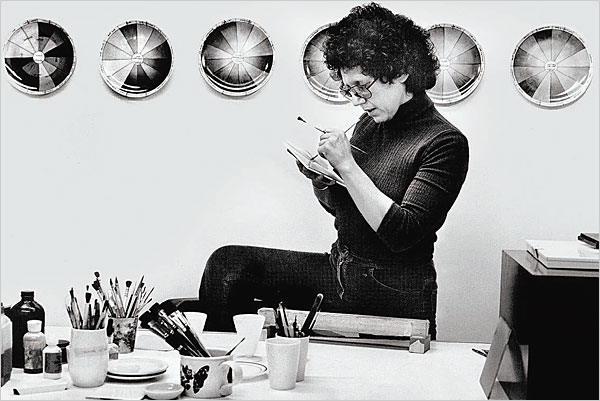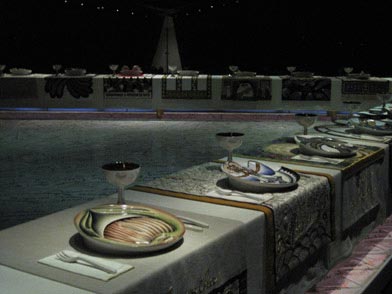| Judy Chicago | |
|---|---|
 |
|
| Born | Judith Sylvia Cohen July 20, 1939 Chicago, Illinois, United States |
| Nationality | American |
| Movement | Contemporary Feminist art |
| Field | Installation Painting Sculpture |
| Works | View Complete Works |
Judy Chicago was born Judith Sylvia Cohen in Chicago in 1939. Her father, Arthur Cohen, came from an extensive generation of Jewish rabbis. However, unlike his familial predecessors he was a very strong-minded political activist and a role model to his beloved daughter Judy. Judy Chicago’s mother, previously a dancer, was employed as a medical secretary. Working women were extremely rare and practically frowned upon by society yet she did anyway. It was her father’s liberal view towards the female gender as well as his support of workers’ rights that had a strong influence on Chicago’s thought process and her belief system. From her mother, she acquired her artistic talents. Both parental influences would be the foundation of not only her future career but also her very way of thinking and living.
At an early age Judy Chicago showed a keen interest in the arts and so her parents enrolled her in the Art Institute in her hometown of Chicago Illinois at the age of three years. When she was five years old, Chicago knew that art going to be her life and vowed that she would do nothing but make art when she grew up. As she grew to be a famous artist, Judy Chicago refused to allow her beliefs to be swayed but instead she steadfastly stuck to her convictions. This is easily seen in all her art but most especially in her most famous works, such as The Dinner Party, The Birth Project, and The Holocaust Project.
Early Career and Education
Judy Chicago applied for admission at the art institute where she had studied as a young child but her application was not accepted. However The University of California at Los Angeles did accept her application and so she attended on a scholarship. While attending UCLA, Chicago became active in politics and designed political posters for the National Association for the advancement of colored people. Her support of their cause as well as her belief in their cause earned her the title of corresponding secretary of their organization.
Life Changes
In 1959 Judy met and fell in love and subsequently left the University to move in with Jerry Gerowitz. Living with Jerry allowed her to have her first studio space where she was able to work on her projects. Life with Jerry was filled with love, laughter and excitement. In fact it was later in the year while Chicago’s mother and brother were in the process of moving to California to be closer to her that she and Jerry hitched a ride to New York. She and Jerry lived in Greenwich Village a few months but soon returned to Los Angeles so that Chicago could finish her degree. Chicago became Judith Sylvia Gerowitz following her marriage to Jerry in 1961 and in 1962 she received her bachelor of fine arts degree and enjoyed a membership in Phi Beta Kappa.
A year later in 1963 tragedy struck and Jerry was killed in a car wreck. The shocking loss of her beloved husband and best friend had a crushing effect on Chicago and she suffered a deep sense of identity crisis until later in the decade. She did however gain her Masters in fine arts from UCLA in 1964.
While attending graduate school Judy Chicago created an abstract piece that was easily recognized as the sex organs of a man and a woman. In this creation; called Bigamy, Judy Chicago depicted a penis suddenly halted before it could join with the vagina. Her abstract of sexual organs totally shocked her mostly male instructors yet for Judy, the abstract represented the death of her late husband Jerry Gerowitz.
Later when she declined to enter the Women of the Arts art exposé she was asked why. She calmly replied that she would not take part in any such event where a particular group was labeled.
Yet another artistic reference to her late husband’s death was her ice sculptures. Chicago’s ice sculpture exemplified an analogy of the delicate value of life and how quickly it could be eradicated.
The late 1960’s found Judy Chicago’s globular acrylic pliable dome sculpture and drawings to be the forerunner of the visionary art movement as was noted by Art in America. An art museum in Pasadena displayed a series of Chicago’s works in a test gallery.
In an effort to form her own identity, separate from her father or husband, she petitioned the courts to legally change her last name to Chicago; a nickname given her because of her strong Chicago accent and strong personality. After written consent of her present husband, her request was granted.
Chicago is best known for three particular pieces: The Dinner Party, 1979, a design done with needlework; The Birth Project, 1985; and The Holocaust Project, 1993. The Dinner Party and The Birth Project recapitulated Judy’s position as being a feminist artist and her view that women have not been mentioned in verbal accounts of history. The Holocaust Project was, as reported by Judy Chicago (1939) her attempt to understand such a horrific historical event. Despite the contention surrounding these three art works they were highly popular albeit by those who were not savvy to the art world.
Judy Chicago also wrote an autobiography recounting her struggles as a female artist and her involvement in the 1970s women’s movement. Judy’s work also ran alongside with several aria tendencies of the 1960s visual arts.
Judy Chicago was not only an American activist and artist but also an author of numerous books and magazine articles. Her autobiography was published in 1982, followed by The Second Decade a few years later. Both these books tell Judy’s story and eloquently describe her struggles as a female artist and author in a male-centric world.
